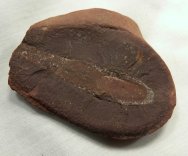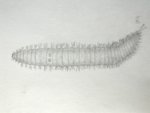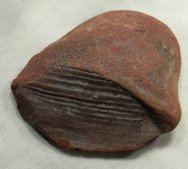Astreptoscolex
anasillosus
Phylum Annelida,
Class Polychaeta
Calamites sp
Calamitales Geological
Time: Pennsylvanian (~300
m.y.a.)
Size (25.4
mm = 1 inch): Worm fossil is 40 mm long by 8 mm across; Plant fossil:
37 mm long by 17 mm across Matrix: 47 mm by 38 mm half
Fossil Site:
Pit 11, Francis Creek Shale, Braidwood, Illinois
Code: MZF17
Price: Sold
 Description:
The Mazon Creek deposits of the region near Braidwood, Illinois
rival the other famous Lagerstatten of the Burgess Shale, Solnhofen,
and Liaoning for the variety of detailed life preserved. Many
exquisitely-preserved specimens are found in the ironstone nodules
that make up the deposits. The majority of collecting areas are
the spoil heaps of abandoned coal mines, the most famous of which
is Description:
The Mazon Creek deposits of the region near Braidwood, Illinois
rival the other famous Lagerstatten of the Burgess Shale, Solnhofen,
and Liaoning for the variety of detailed life preserved. Many
exquisitely-preserved specimens are found in the ironstone nodules
that make up the deposits. The majority of collecting areas are
the spoil heaps of abandoned coal mines, the most famous of which
is  Peabody Coal Pit 11. Pit 11 now serves as a cooling pond for
the Braidwood nuclear power plant, but with over 100 localities,
specimens still come to light. The Polychaeta (Bristleworms)
have a diverse representation among Mazon Creek specimens. The
segmented bodies of the Polychaeta have paired lobes called parapodia
which have a function in locomotion or respiration. The parapodia
bear numerous bristles which are the source of the name of the
class (Polychaeta means many bristles). This one is thought to
have been a predatory species, as are many modern-day bristleworms.
The reverse shows a segment of the plant Calamites whose only
living relative is the horsetail Equisetum. Peabody Coal Pit 11. Pit 11 now serves as a cooling pond for
the Braidwood nuclear power plant, but with over 100 localities,
specimens still come to light. The Polychaeta (Bristleworms)
have a diverse representation among Mazon Creek specimens. The
segmented bodies of the Polychaeta have paired lobes called parapodia
which have a function in locomotion or respiration. The parapodia
bear numerous bristles which are the source of the name of the
class (Polychaeta means many bristles). This one is thought to
have been a predatory species, as are many modern-day bristleworms.
The reverse shows a segment of the plant Calamites whose only
living relative is the horsetail Equisetum.
|
|


